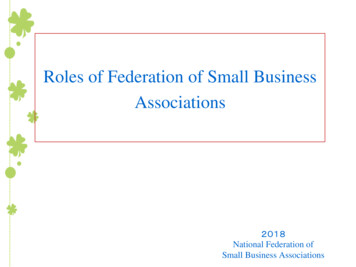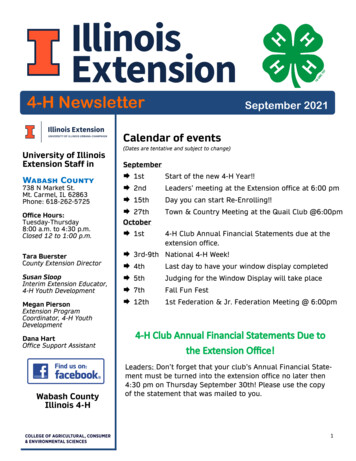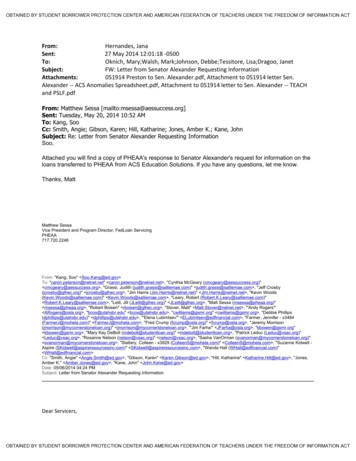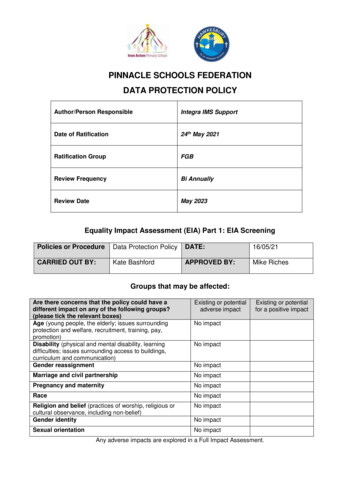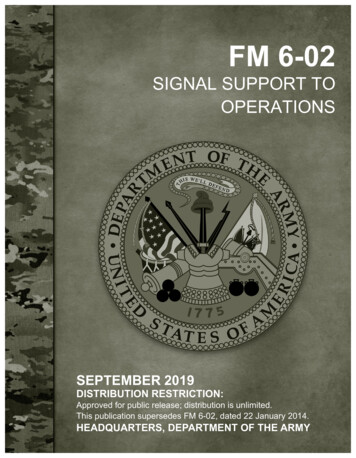
Transcription
FM 6-02SIGNAL SUPPORT TOOPERATIONSSEPTEMBER 2019DISTRIBUTION RESTRICTION:Approved for public release; distribution is unlimited.This publication supersedes FM 6-02, dated 22 January 2014.HEADQUARTERS, DEPARTMENT OF THE ARMY
This publication is available at the Army Publishing Directorate site(https://armypubs.army.mil/) and the Central Army Registry d).
*FM 6-02Field ManualNo. 6-02HeadquartersDepartment of the ArmyWashington, D.C., 13 September 2019Signal Support to OperationsContentsPagePREFACE. vINTRODUCTION . viiChapter 1OVERVIEW OF SIGNAL SUPPORT . 1-1Section I – The Operational Environment . 1-1Challenges for Army Signal Support . 1-1Operational Environment Overview . 1-1Information Environment . 1-2Trends. 1-3Threat Effects on Signal Support . 1-8Section II – Fundamental Principles of Signal Support. 1-13Operational Focus . 1-13Interoperability . 1-14Agility . 1-14Trusted Systems . 1-15Shared Networks . 1-16Network Situational Awareness . 1-16Objectives of Signal Support . 1-17Core Competencies of the Signal Corps . 1-17Section III – Signal in Army Operations . 1-18Support to Joint Operations . 1-18Army Strategic Roles . 1-18The Army Operational Concept . 1-19Support to Command and Control . 1-20Support to Other Warfighting Functions . 1-21Multinational Interoperability . 1-21Strategic and Operational Reach . 1-22Chapter 2SIGNAL SUPPORT BY ARMY ECHELON, CORE COMPETENCIES, TRAINING,AND THE ARMY NETWORK . 2-1Section I – Signal Support by Echelon. 2-1Corps and Below Organizations With Organic Signal Assets . 2-1Units Without Organic Signal Assets . 2-11Types of Signal Units Leveraged for Support. 2-14Requesting Signal Support . 2-17Support to Other Army Operations . 2-17Signal-Enabling Commands and Staffs. 2-26DISTRIBUTION RESTRICTION: Approved for public release; distribution is unlimited.*This publication supersedes FM 6-02, dated 22 January 2014.FM 6-02i
ContentsSection II – Core Competencies and Essential Capability of the SignalCorps . 2-31Department of Defense Information Network Operations . 2-31Network Transport and Information Services . 2-34Spectrum Management Operations . 2-36Visual Information and Combat Camera . 2-36Communications Security . 2-38Section III – Signal Training . 2-39Individual Signal Training . 2-39Collective Signal Training in Units . 2-40Signal Digital Master Gunner Course . 2-41Section IV – The Army Network . 2-41Department of Defense Information Network . 2-41Department of Defense Information Network-Army . 2-46Chapter 3SIGNAL SUPPORT TO OPERATIONS TO SHAPE AND PREVENT. 3-1Section I – Operations to Shape . 3-1Overview of Army Operations to Shape. 3-1Signal Operations Assessments . 3-3Risks to Signal Support . 3-3Signal Support. 3-4Additional Shaping Activities . 3-6Consolidating Gains . 3-8Section II – Operations to Prevent . 3-8Overview of Army Operations to Prevent . 3-8Risks to Signal Support . 3-8Signal Support. 3-9Consolidating Gains . 3-11Chapter 4LARGE-SCALE COMBAT OPERATIONS . 4-1Section I – Signal Support to Large-Scale Combat Operations . 4-1Overview of Large-Scale Combat Operations . 4-1Risks to Signal Support . 4-1Signal Support. 4-2Section II – Large-Scale Defensive Operations . 4-4Overview of Large-Scale Defensive Operations . 4-4Signal Support. 4-4Risks to Signal Support . 4-6Section III – Large-Scale Offensive Operations . 4-6Overview of Large Scale Offensive Operations . 4-6Signal Support. 4-6Risks to Signal Support . 4-8Consolidation of Gains . 4-8Chapter 5OPERATIONS TO CONSOLIDATE GAINS . 5-1Overview of Operations to Consolidate Gains . 5-1Signal Support. 5-1Risks to Signal Support . 5-2Appendix AOPERATING IN A CONTESTED ENVIRONMENT . A-1Appendix BSIGNAL PLANNING . B-1Appendix CVISUAL INFORMATION . C-1Appendix DSIGNAL SYSTEMS MAINTENANCE. D-1iiFM 6-0213 September 2019
ContentsAppendix EREQUESTS FOR SIGNAL SUPPORT .E-1SOURCE NOTES . Source Notes-1GLOSSARY . Glossary-1REFERENCES . References-1INDEX . Index-1FiguresIntroductory figure-1. Command and control logic map . viiiIntroductory figure-2. The command and control system .ixFigure 2-1. Department of Defense information network operations technical channels at corpsand below. 2-3Figure 2-2. Department of Defense information network operations components, effects, andobjectives . 2-34Figure 2-3. Department of Defense information network-Army operational view . 2-51Figure 3-1. Shaping activities within an environment of cooperation and competition . 3-2Figure B-1. Operation plan or order paragraph 5 .B-13Figure B-2. Operation plan or order annex H (Signal) .B-14Figure B-3. Parallel sequences of the military decision-making process and troop leadingprocedures. .B-21Figure C-1. Combat camera support request format . C-2Figure E-1. Request for forces process .E-3TablesIntroductory table-1. Modified Army terms . xTable A-1. Common jamming signals .A-6Table B-1. Example primary, alternate, contingency, and emergency communications plan bywarfighting function .B-3Table B-2. The military decision-making process, step 1: receipt of mission .B-4Table B-3. The military decision-making process, step 2: mission analysis .B-6Table B-4. The military decision-making process, step 3: course of action development .B-8Table B-5. The military decision-making process, step 4: course of action analysis .B-9Table B-6. The military decision-making process, step 5: course of action comparison .B-10Table B-7. The military decision-making process, step 6: course of action approval .B-11Table B-8. The military decision-making process, step 7: orders production, dissemination, andtransition .B-12Table D-1. Alignment of units to type of maintenance performed . D-113 September 2019FM 6-02iii
This page intentionally left blank.
PrefaceFM 6-02 is the highest-level signal doctrine manual. It describes how signal Soldiers support Army forces asthey shape operational environments, prevent conflict, conduct large-scale combat operations, andconsolidate gains against a peer threat in joint operations. In order to understand this publication, readersmust be familiar with Army capstone doctrine (ADP 1 and ADP 3-0), ADP 5-0, ADP 6-0, and FM 3-0. FM6-02 supports foundational Army doctrine and establishes context for signal-specific Army techniquespublications.FM 6-02 is applicable to all members of the Army Profession—leaders, Soldiers, and Army civilians. Theprincipal audience for FM 6-02 is Army commanders, leaders, staffs, and signal Soldiers. Commanders andstaffs of Army headquarters serving as a joint task force or multinational headquarters also use applicablejoint or multinational doctrine for command and control of joint or multinational forces. Trainers andeducators throughout the Army also use this publication.Commanders, staffs, and subordinates ensure their decisions and actions comply with applicable U.S.,international, and in some cases, host-nation laws and regulations. Commanders at all levels ensure theirSoldiers operate according to the law of war and the rules of engagement (see FM 6-27). They also adhere tothe Army Ethic as described in ADP 1.FM 6-02 uses joint terms where applicable. Selected joint and Army terms and definitions appear in both theglossary and the text. Terms for which FM 6-02 is the proponent publication (the authority) are marked withan asterisk (*) in the glossary. Definitions for which FM 6-02 is the proponent publication are boldfaced inthe text. For other definitions shown in the text, the term is italicized and the number of the proponentpublication follows the definition.FM 6-02 applies to the Active Army, Army National Guard/Army National Guard of the United States, andthe United States Army Reserve, unless otherwise stated.The proponent for FM 6-02 is the United States Army Cyber Center of Excellence. The preparing agency isthe Doctrine Division, United States Army Cyber Center of Excellence. Send comments andrecommendations on a DA Form 2028 (Recommended Changes to Publications and Blank Forms) toCommander, United States Army Cyber Center of Excellence and Fort Gordon, ATTN: ATZH-OP (FM6-02), 506 Chamberlain Avenue, Fort Gordon, GA 30905-5735; by e-mail to il.13 September 2019FM 6-02v
This page intentionally left blank.
IntroductionCommand and control is fundamental to joint and Army operations. Command and control is the exercise ofauthority and direction by a properly designated commander over assigned and attached forces in theaccomplishment of a mission (JP 1). The Army’s approach to command and control in unified land operationsis mission command.Mission command is the Army’s approach to command and control that empowers subordinate decisionmaking and decentralized execution appropriate to the situation (ADP 6-0). Mission command guidescommanders, staffs, and subordinates in their approach to operations. The command and control warfightingfunction enables commanders and staffs of theater armies, corps, divisions, and brigade combat teams tosynchronize and integrate combat power across multiple domains and the information environment.Commanders cannot exercise command and control alone. Commanders exercise command and controlthrough the command and control warfighting function. The command and control warfighting function isthe related tasks and a system that enable commanders to synchronize and converge all elements of combatpower (ADP 6-0). See introductory figure-1 on page viii.13 September 2019FM 6-02vii
IntroductionIntroductory figure-1. Command and control logic mapA command and control system is the arrangement of people, processes, networks, and command posts thatenable commanders to conduct operations (ADP 6-0). The command and control system enables thecommander and staff to execute the command and control warfighting function. Signal forces provide theviiiFM 6-0213 September 2019
Introductionnetwork, information systems, and information management processes that enable command and control.Signal soldiers implementing the network and information systems and performing their staff tasks enablesecure communications and situational awareness throughout their operational area. This enables thecommander’s exercise of command and control in support of unified land operations. See introductoryfigure-2.Introductory figure-2. The command and control systemBy providing the network and conducting information management tasks to support the knowledgemanagement process in the command and control system, signal formations and staff elements enable securecommunications and situational awareness throughout their areas of operations. Information managementprocesses enable knowledge management and allow commanders to control their formations and synchronizeefforts across warfighting functions while conducting unified land operations.The Army’s network enables every mission, from training the force to executing tactical tasks to influencethe operational environment in large-scale combat operations. The network is the part of the command andcontrol system that provides infrastructure for voice, data, and video connectivity to support operations. Thenetwork disseminates the common operational picture and enables unified action partner integration. Withmodern tactical radio systems able to pass digital information, the network extends as low as the individualSoldier on the battlefield.FM 6-02 outlines signal doctrine in five chapters with supporting appendixes to address tactics andprocedures for signal support to Army operations. The techniques to accomplish the signal missions,functions, and tasks in this field manual appear in signal-specific Army techniques publications.This revision to FM 6-02 adopts new doctrinal terms, force structure, and tactics implemented since the mostrecent update. This manual supersedes FM 6-02, dated 22 January 2014. FM 6-02 chapters include—Chapter 1 section I discusses the operational environment, information environment, and threat as they relateto signal support. Section II introduces the fundamental principles of successful signal support to joint andArmy operations and the core competencies of the Signal Corps. Section III discusses the role of signal forcesin Army operations.Chapter 2 section I discusses signal support to Army operations by echelon—corps and below units withorganic signal capabilities; units without organic signal capabilities; echelons above corps signal units thatprovide support; and signal support to other Army operations. Section II details the core competencies andessential capability of the Signal Corps. Section III discusses individual and collective signal training. SectionIV discusses the joint and Army networks that enable command and control across the range of militaryoperations.Chapter 3 section I discusses signal support to Army operations to shape. Section II discusses signal supportto Army operations to prevent.Chapter 4 section I provides an overview of signal support to large-scale combat operations. Section IIdiscusses signal support to large-scale defensive operations. Section III discusses signal support to largescale offensive operations.Chapter 5 discusses signal support to Army operations to consolidate gains.Appendix A discusses tactics and procedures for operations in a contested environment. It outlines theprocedures when communications systems and networks come under enemy electronic or cyberspace attack.13 September 2019FM 6-02ix
IntroductionAppendix B discusses the role of the signal staff in the military decision-making process. It outlines theprocess and considerations for planning and coordinating Department of Defense information networkoperations, network transport and information services, spectrum management, and communicationssecurity.Appendix C provides procedures for requesting visual information and combat camera support.Appendix D discusses signal systems maintenance. It outlines two-level communications-electronicsmaintenance, the roles and responsibilities for maintenance management in units, and the externalorganizations that provide sustainment maintenance support.Appendix E provides procedures for identifying support requirements and requesting signal support fromnon-organic assets.Based on current doctrinal changes, certain terms for which FM 6-02 is the proponent have been modifiedfor purposes of this publication. The glossary contains acronyms and defined terms. See introductory table1 for specific term changes.Introductory table-1. Modified Army termsTermRemarksnetwork transportModified definitionPro Patria Vigilans! (Watchful for the Country)Signal Corps MottoxFM 6-0213 September 2019
Chapter 1Overview of Signal SupportSignal personnel and units at all echelons provide and secure the network for theircommanders to conduct command and control and integrate the other warfightingfunctions across the range of military operations. This chapter describes the operationalenvironment, the fundamental principles and core competencies of signal support, andthe role of signal forces in support of Army operations.SECTION I – THE OPERATIONAL ENVIRONMENT1-1. Threats to U.S. interests throughout the world are countered by the ability of U.S. forces to respond toa wide variety of challenges along a competition continuum that spans from cooperation to war. U.S. forcesconduct a range of military operations to respond to these challenges.1-2. Signal forces provide communications services that can quickly transition from fixed garrisoninfrastructure to deployed tactical systems to support Army commanders and units as they execute theirassigned missions. The fixed infrastructure on posts, camps, and stations; mobile single-channel radionetworks; and deployed communications sites combine to provide commanders the communications andinformation technology capabilities they need, at the right time and location, across the conflict continuum.CHALLENGES FOR ARMY SIGNAL SUPPORT1-3. The experiences of the U.S. Army in Afghanistan and Iraq in the early 21st century are notrepresentative of the most dangerous conflicts the Army will face in the future. While the Army conductedcombat operations in both locations, for the most part it focused its efforts on counterinsurgency operationsand stability tasks (FM 3-0). In the future, large-scale combat operations against a peer threat will presentmuch more demanding operational tempo and greater lethality.1-4. Army forces participate in operations as part of a joint and multinational force. These operations servea higher political purpose, and they should be planned and executed at each echelon to support that purpose(FM 3-0). Signal planners must include unified action partner interoperability in signal support plans toenable collaboration and synchronization with joint, interorganizational, and multinational mission partners.1-5. Expeditionary forces must be ready to deploy on short notice to austere locations and immediatelyconduct combat operations. Commanders sequence their deployment so the arriving forces can defendthemselves until follow-on forces arrive in the operational area. The earliest arriving forces have limitedcommunications and network capabilities until their organic signal capabilities arrive and establish thenetwork.OPERATIONAL ENVIRONMENT OVERVIEW1-6. Factors that affect operations extend far beyond the boundaries of a commander’s assigned area ofoperations. Commanders and their staffs seek to develop and maintain an understanding of their operationalenvironment. An operational environment is a composite of the conditions, circumstances, and influencesthat affect the employment of capabilities and bear on the decisions of the commander (JP 3-0). Anoperational environment encompasses physical areas of the air, land, maritime, and space domains, as wellas the information environment, which includes cyberspace, the electromagnetic spectrum, and other factors.Threat, friendly, and neutral actors can all affect conditions in the information environment and, by extension,the operational environment. Because cyberspace and the electromagnetic spectrum span all physicaldomains and geographic areas, some of these effects may originate outside the area of operations.13 September 2019FM 6-021-1
Chapter 1Commanders face new challenges in defending capabilities in cyberspace where boundaries are far lessidentifiable. Attacks in cyberspace can originate from, and route through, friendly, neutral, and adversarycountries.1-7. As commanders operate across the range of military operations, signal capabilities must be tailorableto meet the commander’s requirements. The way signal formations deliver communications services variesbased on the mission. Communications requirements during theater security cooperation activities from fixedposts, camps, or stations differ from a brigade combat team commander’s requirements during a movementto contact mission in large-scale combat operations. Signal staff officers and leaders need to clearly articulateto commanders what communications capabilities are available during critical points of an operation and howthese capabilities support the exercise of command and control.1-8. Understanding the operational environment is essential for signal leaders, engineers, planners, systemoperators, and cybersecurity professionals to plan and execute effective signal support. Signal Soldiers mustunderstand signal flow from the end user, through the local area network, through the wide-area network,and the Department of Defense information network-Army (DODIN-A). The Department of Defenseinformation network-Army is an Army-operated enclave of the Department of Defense information networkthat encompasses all Army information capabilities that collect, process, store, display, disseminate, andprotect information worldwide (ATP 6-02.71). As an example, planners should understand how severeweather in Guam may affect satellite communications networks in Korea, or a cyberspace incident in thecontinental United States can quickly traverse the network and affect communications in an operationaltheater.INFORMATION ENVIRONMENT“There is no better example of the challenge ahead than that of the informationenvironment. From moving supplies in the wake of a hurricane disaster to ordering troopsto the Pacific, or addressing the ever-changing cyber[space] threat, the global dependenceon information and networks in everyday activities demands our attention now.”—General Martin E. Dempsey, former Chairman of the Joint Chiefs of Staff1-9. Across the globe, information is increasingly available in near-real time. The DODIN-A provides theability to access this information from anywhere, and at any time. Access to information enables decisionmaking, leadership, and combat power. It is also key to seize, gain, and retain the initiative and to consolidategains in the operational environment.1-10. U.S. forces seek to dominate the information environment to maintain information advantage. Theinformation environment is the aggregate of individuals, organizations, and systems that collect, process,disseminate, or act on information (JP 3-13). In modern conflict, controlling the information environment isas important as controlling key terrain in the physical domains. The information environment is not separateor distinct from the operational environment, but an integral part of it. Any activity that takes place in theinformation environment affects one or more of the warfighting domains.1-11. Cyberspace and the electromagnetic spectrum are parts of the information environment. Cyberspaceis a global domain within the information environment consisting of the interdependent networks ofinformation technology infrastructures and resident data, including the Internet,
FM 6-02 applies to the Active Army, Army National Guard/Army National Guard of the United States, and the United States Army Reserve, unless otherwise stated. The proponent for FM 6-02 is the United States Army Cyber Center of Excellence. The preparing agency is the Doctrine Division, United States Army Cyber Center of Excellence.
